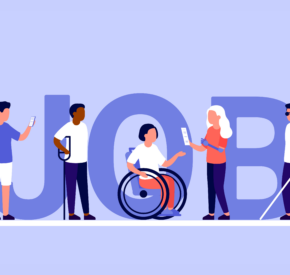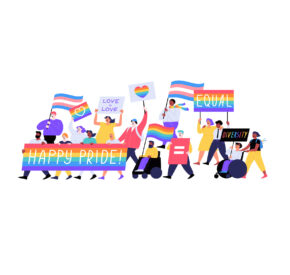Onboarding New Hires with Disabilities – A Learning Experience

Her experience was awful. That’s the adjective I would describe tackling and onboarding a new employee. Each time I tried to solve an issue, others would crop up. Maybe I am being too harsh on myself, but I’ve worked extremely hard to create a ‘white glove’ experience for every new person who joins Tamman, and this was far from that. Allow me to explain.
I began my career 28 years ago as a secretary, then an administrative coordinator, and now I am an Administrative Manager. I love what I do for a living. This work is the perfect job for me. I meet new people and learn about their experiences on one of their best days, their first day of work. I never want to be the person that messes that day up.
I am symbolically the face of the company when someone new comes through the front door and is about to be introduced to the company’s culture and policies. My biggest frustration over the years has always been when initial tools or training are not prepared or set up, or even telling the new hire, “Your computer will be ready in two days. Wait. What?” No matter what, I was prepared and would even find workarounds to catch anything that might fall through the cracks at any level.
Tamman threw me a new challenge – accessibility.
Until I started working at Tamman, it was always someone else’s role. I’ve known accessibility to mean access for all. That’s broad but narrow that down to what we’re talking about for employees with disabilities and ”Accessibility means that people can do what they need to do in a similar amount of time and equivalent effort as someone that does not have a disability. It means that people are empowered, can be independent, and will not be frustrated by something that is poorly designed or implemented.” – Alistair Duggin
Please don’t get me wrong; other companies I worked for had an HR dept that dealt with the responsibility of determining the candidates’ fit for the role, then IT would assess their needs to perform that role. At Tamman, it’s my job to make sure all people with or without disabilities have the easiest onboarding experience. I had one of these down but not the other.
That new hire I felt awful about was a college student who is blind and found out that our existing HRIS system was not accessible. Since I couldn’t use that system with her, I took a look at all the tools we use to process new hires at Tamman. Of course, we wanted to make sure as many of the tools we use are accessible (it’s what we do!) but in my experience, changing the software that is already integrated into all other applications was a task we had to tackle but would need time to research and plan. But we didn’t have time. For all companies, that would be expensive if it was not already worked into the budget for researching, integrating, and then customizing training for the entire company. It can be an awkward experience that makes the new hire feel ambivalent about speaking up for fear of adding to the trouble when this is the last person who should have to worry.
But what to do for the new hire in front of me? My solution had to be user-friendly, accessible, and take existing applications and put them into action immediately for her. I took all the necessary documents for onboarding, e.g., Employee Application, Background Check Authorization (7 pages), I-9, W-4, or W-9, insurance forms, and tested them in the MS Word ribbon under Review > Check accessibility. That feature in Word can let me know if there are any formatting issues for screen readers.
Note: We ordinarily upload pdfs into DocuSign, but without going through the complete remediation and tagging process, it was easier to manipulate and make an MS Word document accessible.
We needed to identify the form fields by adding text for the answer box employees need to fill out. Also, you can add a “tooltip” that appears on mouse-over to give additional details around what is expected in the field. Once all word documents have been identified where a screen reader can pick up exactly how each line is formatted, I uploaded it to DocuSign and sent it out to the new hire. I thought that wasn’t too bad; I put in a little extra elbow grease to check and get everything uploaded…but of course, it wasn’t that easy.
She said the documents in DocuSign still weren’t reading correctly. It was confusing how her screen-reader read the documents to her as it read everything completely out of order for her. DocuSign does have its screen-reader-friendly page, but it works when the document is formatted correctly according to their standards. Sometimes we can’t control outsourced webpages but we can try to build an internal system that is more fluid and open-minded from the beginning.
What are outsourced webpages?
For example, some of the Federal Forms, e.g., W-4 or W-9 for a new hire, are so poorly formatted, and it’s hard to change them. That is where the relationship and the conversation come in handy.
I decided to call her, we went through each Federal form, I sent them to be signed and we were done. She has mentioned how appreciative she was of the call and the sincerity of us making that effort; which is something she was not used to.
When you are dealing with Federal forms or any other outsourced webforms, ask new employees if they need assistance and walk them through the process.
Researching, Researching & Researching
In researching disabilities and the specific needs depending on the disability, it is not always cut and dry where the lines are drawn. More time needs to be spent on ensuring that someone would have no issue or have to spend an extensive amount of time filling out forms. But that is where you need to know who you will be preparing it for.
Who is the next orientation and onboarding experience for?
The best thing I did, which I would strongly suggest to others, is to make a phone call. There is no substitute for building a relationship with someone. It shows you took time to focus on them and assist them in the best way possible. After all, at Tamman, as with other companies, isn’t the main point of new hire on-boarding building relationships? Make sure you connect first with the person, have a friendly tone and conversation with the desire to get to know them better and find out what works for them in filling out documents. Then build their orientation and onboarding from there.
In my case, the first person I was supporting was blind, but what if they weren’t?
What other accommodations do you need to be prepared for, e.g., if a person is deaf, which accommodation do they use, a closed Captioning or an ASL interpreter?
Individuals with physical, mental, or emotional conditions may have serious difficulty concentrating, remembering, or making decisions. They may need someone to assist them in filling out the paperwork or a screen reader to assist with walking through the document.
I needed to consume more information to help me support this new employee and all new hires in this growing company. I researched articles, discussed technologies and obstacles with colleagues, and even attended webinars from the International Association of Accessibility Professionals (IAAP) and A11yTalks.
My attempt to get it right from the beginning without issues did not happen. Some processes will fail; it most definitely was not on purpose. There were multiple errors, unnecessary boxes, and undefined fields required in my case. My work has not been one particular fix; rather, a continuous one, especially since more than one new hire with a disability has been onboarded.
This bears mentioning again, and there is no set way or science; we need to be flexible to make sure the person on the other end of that zoom video, phone call, or in-person meeting knows you will be more than happy to assist them through it. That is my role. Once you hear their past experiences and hear how you made something accessible to them, you’ll see the appreciation. That is priceless.
When I asked our new hire what she thought of all of this, her response was, “I really like your point about building a relationship with the person through just talking to them and asking them what would be best for them. We want to be open to helping people rather than shying away from them because the systems are inaccessible from the start. That is where you guys do an awesome job!”
Accessibility is becoming more of a topic that is being discussed today. It is a right that everyone deserves. I’ve taken full ownership of any missteps or concerns to ensure everyone gets treated equitably, and I will continue to do so.
Both Tamman and our new hire agree, “We ideally want to have a global fix that works for everyone. However, some of those things are out of our hands. But WE can certainly expand internal systems and advocacy.”





